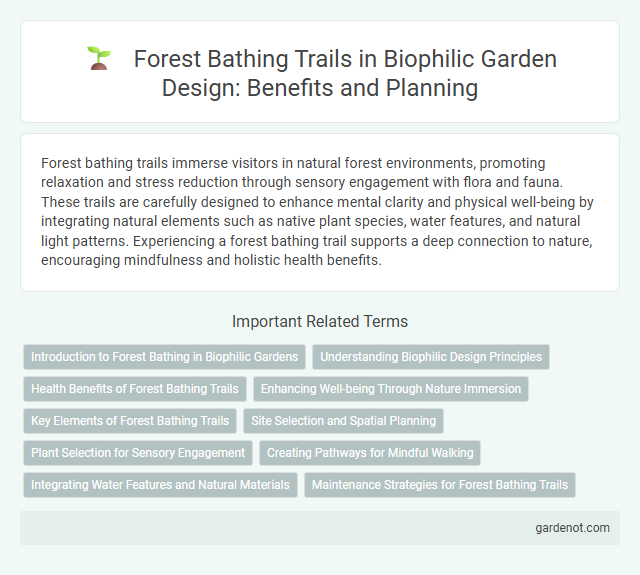Forest bathing trails immerse visitors in natural forest environments, promoting relaxation and stress reduction through sensory engagement with flora and fauna. These trails are carefully designed to enhance mental clarity and physical well-being by integrating natural elements such as native plant species, water features, and natural light patterns. Experiencing a forest bathing trail supports a deep connection to nature, encouraging mindfulness and holistic health benefits.
Introduction to Forest Bathing in Biophilic Gardens
Forest bathing in biophilic gardens involves immersing the senses in natural forest environments to reduce stress and enhance mental clarity. This practice leverages greenery, natural sounds, and textured foliage to create a multisensory experience that reconnects individuals with nature. Incorporating forest bathing trails in urban gardens promotes wellbeing by fostering mindfulness and increasing exposure to diverse plant species.
Understanding Biophilic Design Principles
Forest bathing trails embody biophilic design principles by integrating natural elements that foster sensory engagement and stress reduction. These trails use native vegetation, natural materials, and organic layouts to create immersive environments that promote mental restoration and physical well-being. Emphasizing connectivity to nature, forest bathing paths enhance biodiversity while encouraging mindful interaction with the ecosystem.
Health Benefits of Forest Bathing Trails
Forest bathing trails enhance mental well-being by reducing cortisol levels and alleviating stress through immersive exposure to natural forest environments. Studies show that walking these trails improves cardiovascular health, lowers blood pressure, and boosts immune function by increasing natural killer cell activity. Enhanced concentration, mood stabilization, and reduced symptoms of anxiety and depression are significant psychological benefits linked to regular forest bathing experiences.
Enhancing Well-being Through Nature Immersion
Forest bathing trails offer immersive experiences that harness the therapeutic benefits of nature exposure, promoting stress reduction, improved mood, and enhanced mental clarity. By integrating sensory engagement with natural elements such as trees, water, and fresh air, these trails stimulate relaxation and mindfulness, supporting overall well-being. Studies indicate that spending time in forest environments can lower cortisol levels and boost immune function, making forest bathing a vital component of biophilic design in health and wellness spaces.
Key Elements of Forest Bathing Trails
Forest bathing trails incorporate natural elements such as dense tree canopies, diverse native plant species, and quiet, meandering paths to promote mindfulness and sensory immersion. Key elements include strategically placed seating areas for contemplation, natural sounds like flowing water or bird songs, and minimal artificial lighting to maintain a connection with nature. These components enhance the therapeutic benefits of forest bathing by fostering relaxation, reducing stress, and improving mental clarity.
Site Selection and Spatial Planning
Site selection for a forest bathing trail emphasizes proximity to diverse native vegetation, quiet environments, and natural water features to enhance sensory immersion and stress reduction. Spatial planning integrates gentle slopes, wide pathways, and resting areas positioned to maximize exposure to sunlight, shade, and biodiversity hotspots. Thoughtful trail layout balances ecological preservation with visitor accessibility, fostering restorative experiences aligned with biophilic design principles.
Plant Selection for Sensory Engagement
Selecting diverse native plants with varied textures, scents, and colors enhances sensory engagement along forest bathing trails, promoting mindfulness and stress relief. Incorporating fragrant species such as lavender or pine stimulates olfactory senses, while textured bark and soft foliage encourage tactile interaction. Strategic plant placement also supports visual interest and biodiversity, increasing overall biophilic connection.
Creating Pathways for Mindful Walking
Forest bathing trails enhance biophilic design by creating pathways that encourage mindful walking, immersing individuals in natural surroundings to reduce stress and improve mental clarity. These trails integrate sensory elements like textured soil, native plants, and gentle slopes to foster a deep connection with the forest ecosystem. Mindful walking along forest bathing paths promotes physiological benefits such as lowered cortisol levels and increased parasympathetic nervous system activity.
Integrating Water Features and Natural Materials
Forest bathing trails enhance well-being by integrating soothing water features such as streams, waterfalls, and ponds that promote relaxation and sensory immersion. Natural materials like wood, stone, and moss reinforce the connection to the environment, creating tactile pathways and resting spaces that harmonize with the forest ecosystem. These elements collectively support mental restoration and deepen the biophilic experience through multisensory engagement.
Maintenance Strategies for Forest Bathing Trails
Effective maintenance strategies for forest bathing trails prioritize regular monitoring of trail conditions, employing sustainable practices to prevent soil erosion and minimize environmental impact. Utilizing native vegetation for trail borders and implementing controlled foot traffic zones help preserve the natural ecosystem while enhancing visitor experience. Routine cleanup, combined with adaptive management techniques, ensures long-term trail health and supports biodiversity conservation within biophilic design frameworks.
Forest bathing trail Infographic

 gardenot.com
gardenot.com